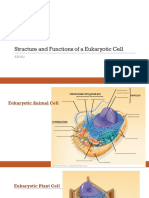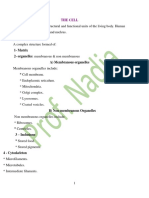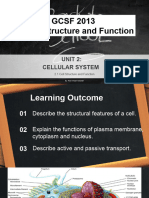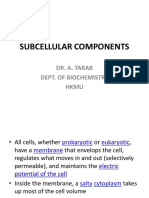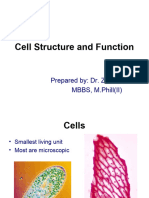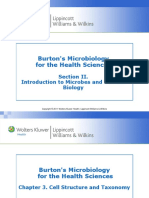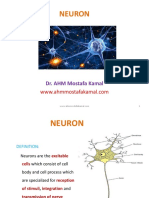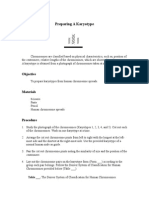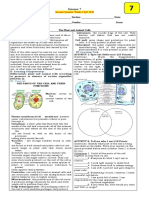THE CELL
• multicellular organisms are made up
of two distinct structural components:
cells
and
extracellular material
Eukaryocytes
• all animal cells, including humans, are eukaryotic cells
• eukaryocytes are characterized by:
a distinct membrane-bound nucleus
well-defined subcellular compartments bounded by
lipid membranes
• sub-cellular compartments constitute organelles
which are the sites of distinct biochemical processes
examples of organelles are mitochondria &
Eukaryotic cell
Electron micrograph of a plasma cell. Only a single membrane (the plasma membrane)
surrounds the cell, but the interior contains many membrane-limited compartments,
or organelles. The cellular DNA is segregated within a defined nucleus, which is
bounded by a double membrane.
Prokaryocytes
• in contrast, prokaryotic cells of bacteria:
typically have a cell wall around the
cell membrane
• lack membranous structures
including an envelope around the
nucleus
Prokaryotic cell
Electron micrograph of a thin section of Escherichia coli, a common intestinal
bacterium. The nucleoid, consisting of the bacterial DNA, is not enclosed within a
membrane. E. coli and some other bacteria are surrounded by two membranes
separated by the periplasmic space. The thin cell wall is adjacent to the inner
membrane.
Cell and Cytoplasm
• Cells maintain proper homeostasis of the body
• Certain structural features are common to all cells
• Protoplasm of each cell consists of
two major components; nucleus and cytoplasm
•Cytoplasm contains several structures representing:
organelles
inclusions
The cell membrane (plasmalemma / plasma membrane)
• cell membrane is composed of:
Lipids: phospholipids (most abundant), sphingolipids and
cholesterol
Proteins; intergral (transmembrane, intrinsic) and peripheral
proteins
Carbohydrates; mainly oligosaccharides. Occur as glycoproteins
and glycolipids.
Occur on cell surface coat as glycocalyx =cell adhesion and
recognition
• Membranes range from 8 to 10 nm thick consequently are visible
Glycocalyx (contn.)
• Carbohydrates associated with the red
blood cell plasma membrane are unique
• they determine whether a person’s blood
type is:
A , B, AB or O
Molecular Organization of Cell Membrane
• Lipid bilayer in fluid state, hence the fluid mosaic model
“protein icebergs in a lipid sea”
• Phospholipids distributed in two layers with polar heads
on inner and outer surfaces
• Nonpolar tails in center of membrane
•Phospholipds are thus amphipathic (hydrophilic& phobic)
The two leaflets of the bilayer contain different types of
lipids as indicated by the differently colored head groups.
Single & multipass integral proteins
Peripheral proteins
The cell membrane (contn.)
• electron micrographs reveal that the cell membrane
exhibit a trilaminar structure in osmium-
stained tissues
• membranes surrounding organelles have a similar
structure
• trilaminar structure constituted by:
two dense lines, each 3 nm wide
a clear zone, about 2 to 4 nm wide,
separating the dense lines
• All cellular membranes have this appearance hence
the 3-layered structure has been referred to as the
unit membrane
UNIT MEMBRANE
EM of 2 adjacent cells –
note trilaminar nature
of the cell membrane
Functions of the cell membrane???
Functions of the cell membrane
• maintains the structural integrity of the cell
• controls movements of substances in & out of the
cell (selective permeability)
• regulates cell-cell interactions
• recognizes, via receptors; antigens & foreign cells
as well as altered cells
• acts as an interface between the cytoplasm &
extracellular fluid
• establishes transport systems for specific
molecules
• responds to extracellular stimuli – this is called
Cell Membrane Permeability and Transport
• Selective permeability
Passive diffusion
Active transport
Facilitated diffusion: some substances e.g. glucose
are helped across the membrane by a membrane
component usually intergral proteins (carrier or
channel proteins.)
Often unidirectional, no energy but follows
concentration gradient.
Channel proteins
Here a protein forms an aqueous channel that allows
water molecules or ions to cross the membrane
Most channels only permit passage of inorganic ions &
are therefore called ion channels
Some ion channels are open much of the time they
are referred to as non-gated channels
Most ion channels open only in response to specific
chemical or electrical signals these are referred to as
gated channels
Transporter /carrier protein
Here the diffusing substance first binds selectively to
an integral protein
Latter is called a transporter (carrier) protein the solute
binds to the transporter protein on one side of the
membrane this triggers a conformational change in the
protein in one conformation, the carrier protein
exposes solute-binding sites to the exterior of the cell
in another conformation, it exposes the solute-binding
sites to the cell interior thus a transporter protein
alternates between two conformations.
The transporter is shown in three conformational states: in the outward open state, the
binding sites for solute are exposed on the outside; in the occluded state, the same sites are
not accessible from either side; and in the inward-open state, the sites are exposed on the
inside. The transitions between the states occur randomly. They are completely reversible and
do not depend on whether the solute binding site is occupied. Therefore, if the solute
concentration is higher on the outside of the bilayer, more solute binds to the transporter in
the outward-open conformation than in the inward-open conformation, and there is a net
transport of solute down its concentration gradient (or, if the solute is an ion, down its
electrochemical gradient).
Larger molecules enter cell by specialized transport
mechanisms
• Endocytosis is ingestion of extracellular material into cell
Pinocytosis is ingestion of extracellular fluid= “cell drinking”
Phagocytosis is uptake of large, solid particles= “cell eating”
Receptor-mediated endocytosis. The receptors are plasma
membrane proteins that bind only with certain molecules.
e.g. insulin and LDLs-low density lipoproteins; the molecules
that carry cholesterol to the body cells. Harmful substances
such as some toxins and viruses also use this mechanism.
•Exocytosis is release of material from the cell
Phagocytosis involves the extension from the cell of large folds called pseudopodia which engulf
particles, for example bacteria, and then internalize this material into a cytoplasmic vacuole or
phagosome that will be acted upon by lysosomes
Membrane trafficking
• is a process of membrane movement
& recycling
• during endocytosis, portions of the cell
membrane become endocytotic vesicles
• during exocytosis, the membrane is
returned to the cell surface
• trafficking is crucial for cell maintenance
• Is also physiologically important in processes such as
Cell membrane specialisations
1. Cilia
2. Microvilli
3. Stereocilia
Cellular Organelles
Mitochondria
A mitochondrion is a membranous
organelle
Involved in generating energy for the cell
Under the TEM, each mitochondrion
possesses a smooth outer membrane &
a folded inner membrane folds of the
inner membrane are known as cristae
Latter greatly increase the surface area
of the membrane
Number of cristae is related directly to
the energy requirement of the cell
Matrix is a gel containing numerous enzymes
Inner membrane surface in contact with the matrix
has many protein complexes-mitoribosomes
Oxidative phosphorylation takes place here to
generate most of the cell's ATP
Can rapidly change their shape are capable of fusing
with one another so as to enlarge
Are self-replicating in that they are generated from
pre-existing mitochondria
Rough Endoplasmic Reticulum/granular ER
• Exhibits interconnected cisternae with ribosomes
•Shows continuity with nuclear membrane
• Highly developed in protein-synthesizing cells
• Synthesizes proteins for export or lysosomes
• Synthesizes integral membrane proteins and
phospholipids (membrane factory)
Reticulum: anastomosing network of membranes thatform cisternae
Smooth Endoplasmic Reticulum
• Devoid of ribosomes and consists of anastomosing
tubules
• Found in cells that synthesize phospholipids, cholesterol
(lipid metabolism) and steroid hormones
• In liver cells, proliferates to deactivate or detoxify
harmful chemicals
• In skeletal and cardiac muscle fibers, stores calcium
between contractions = sarcoplasmic reticulum
Golgi Apparatus “post office”
• Present in all cells, highly developed in secretory cells
• Consists of stacked, curved cisternae with convex side as
the cis face
• Mature concave side is the trans face
• Cisternae enzymes modify, sort, and package proteins
• Adds sugars to proteins and lipids to form glycoproteins,
glycolipids, and lipoproteins
• Secretory granules are modified, sorted, and packaged in
membranes for export outside of cell or for lysosomes
Proteins and other
products of the ER
are sent to the
Golgi apparatus,
which organizes,
modifies,
packages, and tags
them. Some of
these products are
transported to
other areas of the
cell and some are
exported from the
cell through
exocytosis.
Enzymatic proteins
are packaged as
new lysosomes (or
packaged and sent
for fusion with
existing
lysosomes)
Ribosomes
•Not membrane bound
• Appear as free and attached (as to endoplasmic
reticulum) In either case, some ribosomes exist individually
while others line up in chains called polyribosomes
• Most abundant in protein-synthesizing cells
• Decode genetic messages from nucleus for amino acid
sequence of protein synthesis
• Free ribosomes synthesize proteins for cell use
• Attached ribosomes synthesize proteins that are packaged
for export or lysosomes use
Lysosomes
• Filled with hydrolyzing or digesting enzymes
•Acid phosphatase occurs in lysosomes=distinguish
• Separated from cytoplasm by membrane
• Functions in intracellular digestion or phagocytosis
• Digest microorganisms, cellular debris, worn-out cells, or
cell organelles
• Residual bodies seen after phagocytosis
• Very abundant in phagocytic and certain white blood cells
Peroxisomes
•They contain a variety of enzymes that break down
poisons e.g. alcohol, phenol, formaldehyde
•Contain oxidases that form hydrogen peroxide
• Contain enzyme catalase to eliminate excess
hydrogen peroxide
• Abundant in liver and kidney cells=detoxification
•Peroxisomes breakdown very long chain fatty acids
Cytoskeleton
cytoskeletal components are also
critical for:
(i) cell motility
(ii) cell reproduction
(iii) transportation of substances
within the cell
• cytoskeleton
consists of 3
different kinds
of protein-
based
filaments:
microfilaments
intermediate
filaments
The Cytoskeleton of the Cell
Microfilaments
• Thinnest microfilaments in the cytoskeleton
• Composed of protein actin
• Distributed throughout cell and used as anchors at cell
junctions
• Form core of microvilli and terminal web at cell apices
Intermediate Filaments
• Thicker than microfilaments
•Are made up of long fibrous subunits of a protein
called keratin that are wound together
• Myofilaments found in smooth and skeletal muscles
• Neurofilaments found in the nervous system
• intermediate filaments:
are important for maintaining cell
shape & structure-mechanical stability
resist tension, i.e., forces that pull
apart cells
help anchor organelles together within a cell
link cells to other cells by forming special
cell-to-cell junctions (at desmosomes)
Microtubules
• Largest filaments in cytoskeleton
• Composed of protein subunits called tubulin
• Most visible in cilia and flagella
•Microtubules are involved in the process of cell
division
NB: Centrioles are two short, identical microtubule
structures found near the nucleus
Centrioles
•• Centrioles perpendicular to one another; contain nine
clusters of three microtubules each (9+3)
• Before mitosis, centrioles replicate
• During mitosis, centrioles form mitotic spindles
•In addition, centrioles are the basal bodies that guide
the formation of cilia & flagella
9+3
Inclusions
• are non-living components of the cell that:
do not possess metabolic activity
are not bounded by membranes
are not essential to the life or
functioning of the cell
Inclusions (contn.)
• inclusions represent:
metabolic products
storage materials
foreign substances taken into the
cell from the environment
Inclusions (contn.)
• most common inclusions are:
glycogen
lipid droplets
pigments
Pigments
• naturally occurring pigments in human
cells include:
melanin
lipofuscin
hemosiderin
Lipofuscin
• also sometimes called the "wear &
tear" pigment
• is a yellow-to-brown pigment whose
amount increases with age
• represents indigestible remnants of
lysosomal activity
Hemosiderin
• is a golden brown pigment
• derived from breakdown of hemoglobin
present in red blood cells
Crystals
• not commonly found in cells - exception is:
Sertoli cells (crystals of Charcot-Böttcher)
interstitial (Leydig) cells (crystals of Reinke)
occasionally macrophages
• believed that these crystals are a storage
form of proteins
Nucleus and Nuclear Envelope
• Nucleus contains chromatin, nucleoli, nuclear matrix,
and cellular DNA
• Double membrane called the nuclear envelope
surrounds the nucleus
• Outer membrane of nuclear envelope contains
ribosomes
• Nuclear pores at intervals in the nuclear envelope
• Nuclear pores control movements of material between
nucleus and cytoplasm
Primary oocytes – note clamps of heterochromatin (electron
dense, inactive form)
Nucleolus
• nucleoli are sites where ribosomal
RNA (rRNA) is synthesized
• a cell may contain several nucleoli
• usually only one or two large nucleoli
are found
Cilia
• Motile apical surface modifications
• Line cells in the respiratory organs, uterine tubes, and
efferent ducts in testes
• Motility caused by sliding microtubule doublets
• Motor protein dynein uses ATP to move cilia
Microvilli
• Nonmotile apical surface modifications
• Well developed in small intestines and kidney
• Main function is absorption







